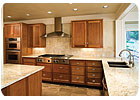
Photo ©Atelier Wong/courtesy of Through the Lens Mgt.
When building a spec home in Austin, TX, Steve Wauson of Craftsman Homes of Austin adhered to a few design objectives. Above all, it was a priority to utilize as many natural materials as possible - making for environmentally friendly architecture. In doing so, an assortment of natural stone - including several regional varieties - was employed throughout the home’s interior and exterior spaces.
“The design of the house is Arts and Crafts,” said Wauson, adding that this style also played a significant role in the decision-making process. “It has low-pitched roofs, and we wanted to make sure that it blends with the surroundings. We wanted to keep it simple and elegant in detailing. The Arts and Crafts style has been around since the late 1800s, and it has evolved to using natural materials. It’s all about ‘Going Green.’ It is a century-old idea that really makes sense today. Natural stone really works well into that idea.”
According to Wauson, the stone palette used throughout the 5,000-square-foot home presents a two-fold message: timelessness and understated elegance. The specific types of stone chosen for the design offer a sense of richness, while still providing a neutral canvas for furnishings.
“[When building a home], we try to have an open floor plan, but we also try to define individual spaces,” said the builder. “We also do that with the floor pattern. There is an individual pattern for each space.”
Mexican travertine, which was supplied by Materials Marketing of Austin, TX, was selected as flooring throughout the interior spaces. A total of five colors - Latte, Café Noir, Carmel, Gaillo and Vintage - were used in all. To create the floor patterns throughout the home, 2- x 2-foot pieces of travertine were brought on site and then sawn to various-sized pieces, explained Wauson.
The travertine was used for interior floors in formal areas as well as for countertops, wainscoting and shower surrounds in the bathrooms and the kitchen. Additionally, the vanity in the master bath is fabricated from Jerusalem Stone, while the kitchen countertop is made of Honey granite. The material for both applications were supplied and installed by Southwest Marble & Granite of Austin, TX.

Photo ©Atelier Wong/courtesy of Through the Lens Mgt.
Exterior stonework
In keeping with the “green” objective of the design, the home’s exterior stonework features several local materials. A blend of Texas limestone flagging forms the patios and walkways. “The Texas blend is predominantly a cream color mixed with blues and some Lueders [limestone],” said Wauson. “They go very nicely together.”For all of the exterior columns, Texas Chopped Block limestone was used. Randy Gott Masonry was responsible for the installation of all outdoor applications.
To create the pond and grotto, limestone was actually gathered from a field on the property. “The house sits on the side of a hill,” explained Wauson. “To do the foundation, we excavated to level the surface. We also lowered the grade out at the entry site. We took the limestone that was excavated on site and stacked it, starting at the bottom of the lot. It’s a nice level ground, so we put a pond there.”
According to the builder, the excavated limestone has a weathered finish, which blends well with its surroundings. The limestone was accented with a different variety of limestone that was originally found in caves, explained Wauson. “It has holes in it, so we call it ‘Holy Rock’,” he said.
The limestone blocks were dry-stacked and then tied with rebar. “By stacking [the stone] and tilting it back, it gives us a chance to make little areas for the rainwater to soak in better,” said Wauson. “Also, stacking gives us a chance to put planting in. There are a lot of green things on site.”
In total, construction was completed in 15 months. “Things went pretty well,” said Wauson. “We’ve been doing this a long time, so we know what to look out for. I am on site all the time.”
